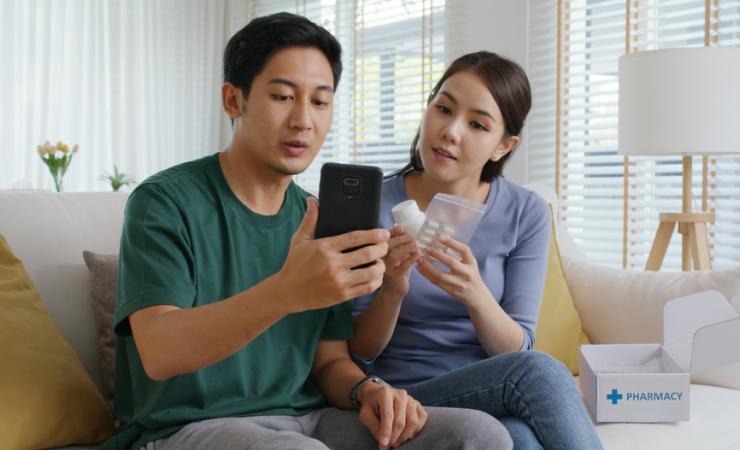When you open a box of medication, you’re confronted with a thick wad of paper – the medicinal product information sheet. As a patient, this gives you all the necessary information about the medication – ingredients, side effects, dosage, whether you can take it while pregnant or breastfeeding, or warnings not to take it in combination with other drugs.
However, we are living in a digital world and paper leaflets are extremely wasteful. If all of the information leaflets that are produced in one year globally were laid out flat and placed on top of each other, the pile of paper would be well over 500km high, and current paper leaflet production generates an estimated 500,000 tonnes of carbon dioxide every year. However, providing paper information leaflets is a legal requirement for drug manufacturers. Digital versions could cut down on paper waste while simultaneously ensuring that the patient always has access to trusted and up-to-date information, backed up by blockchain technology.
This is where PharmaLedger and Gravitate Health come in.
PharmaLedger’s solution focuses on the use of blockchain to create a decentralised backbone for storing and transporting health data safely. The information, which comes from a trusted source such as a government agency, is then passed along a blockchain, which ensures – transparently – that its integrity is safeguarded.
“The holy grail of the pharmaceutical supply chain is traceability, track and trace. Where did it come from? Where is it going to? Fundamentally blockchain ensures secure data exchange and confidentiality,” says Daniel Fritz, industry lead of the PharmaLedger project and executive director of the newly formed PharmaLedger Association. “You use the app to scan the barcode on the packaging of your medicine and it gives you access to real-time up-to-date information about the medical product.”
A key benefit of PharmaLedger’s ePI app is that it is open-source technology which is not owned by any one company. This means it could be rolled out rapidly and is not likely to be held up by red tape or contract battles.
“This is a company-agnostic solution and it could easily scale to multiple countries relatively quickly with the involvement of the health authorities,” says Fritz.
It’s also user-friendly, so that anyone who has the app on their phone can easily gain access to up-to-date, trustworthy information about their medicine – in the language of their choosing. Users also don’t need to be familiar with blockchain to benefit from it, Fritz says.
“The blockchain is a foundational element that is working in the background – it’s not something that a patient wants or needs to see.”
Focusing on the relevant information
In the typical lengthy medical product information leaflet, it’s not always easy to find the information that’s relevant to your individual case. For instance, you might be pregnant or breastfeeding, and you need to find out how you can take medicines safely.
Gravitate-Health have developed a digital system for patients where, when you check an electronic product information leaflet, a tool called the G Lens® highlights information that’s specifically relevant for you.
“With Gravitate Health and the G-lens® we want to add value directly for patients, by using the G-lens® services. We also explore strategies to make the information more understandable – staying within the ramification of patient safety, medical accountability and legal and regulatory requirements,” says Anne Moen, coordinator of the Gravitate-Health project and professor at the University of Oslo.
To demonstrate how the technology works, the project invented several personas with different health profiles.
“For Alicia’s persona, if I put in “HIV” and press apply lens, the app will highlight the sections in the ePI that have information about HIV. If I add “allergy”, then it should highlight that information,” says Moen.
The G-lens® services also enable patients to switch between different languages, so that they can read the medical information in their native tongue, no matter which language is spoken in the country that the product was bought in.
To ensure that the project is creating a solution that is fit-for-purpose, Gravitate-Health has gotten feedback from a range of future users: patients, health professionals and citizens. A user advisory group made up of 20 patients, who were recruited by the European Patient Form, is regularly consulted by the project.
“In total more than 3500 future users have contributed to different aspects of our work,” says Moen. “For Gravitate-Health it’s very helpful to have this direct interaction with the “patient voice”. The advisory group also reviews our solutions, tests them and returns with feedback.”
PharmaLedger and Gravitate Health’s outputs will make it easier and more secure for patients around the world to access and trust electronic medical information.
“Making it easier and more accessible can accelerate a “digital first” ePI scenario. The two projects have contributed with different strategies and solutions,” says Moen.
Gravitate-Health and PharmaLedger are supported by the Innovative Medicines Initiative, a partnership between the European Union and the European pharmaceutical industry.
